Economics
Materials Manufacturing Industries—A Taxonomy and
Analysis
Paul S. Follansbee
CONTENTS
An expanding manufacturing sector has enabled strong economic growth in
the United States for close to a century. Manufacturing industries have
provided high-paying jobs for workers across the nation as well as substantial
incentives for technical innovation. Seventy-five percent of U.S. scientists
and engineers are employed in manufacturing establishments, and an equal
percentage of industrial R&D is performed by manufacturers. Manufacturing
firms performed $91.2 billion worth of R&D in the United States in 1992;
company and other nonfederal government sources accounted for 79.4% of this
amount.1 In 1993, 18% of the gross domestic
product of the United States was directly attributed to manufacturing trade;
this percentage climbs considerably higher when goods and services indirectly
related to manufacturing (e.g., software development and sales, engineering
services, etc.) are included.
In recognition of the essential role played by manufactuing and in fulfillment
of a mandate from the U.S. Congress, the U.S. Department of Commerce's Office of Technology Policy
recently completed a report detailing the state of manufacturing in the United
States.2 The full report provides an assessment
of all manufacturing activities as defined by the U.S. Census Bureau's standard industrial classification (SIC) system. This article reviews the findings of
the study as they relate to materials industries. The trends reported are
expected to be representative of materials manufacturers, at least to a first
approximation.
The Census Bureau's SIC system defines manufacturing industries as those in
classes SIC 20 (food and kindred products) through SIC 39
(miscellaneous manufacturing industries). Included within this classification
are everything from aircraft engines (SIC 3724) to zippers (SIC 3965). In the
Department of Commerce's report, the 20 SIC manufacturing categories were
divided into 41 individual industry groups (Table I). Each of these industry
groups is reliant upon materials and materials technologies to some degree,
which illustrates the pervasive impact of materials in manufacturing. However,
five groups in Table I are particularly pertinent to the materials
community—ferrous metals, nonferrous metals, plastics and plastics products,
electronic components, and nonmetallic material products. Table II lists the
SIC designations and example products for each of these industry groups.
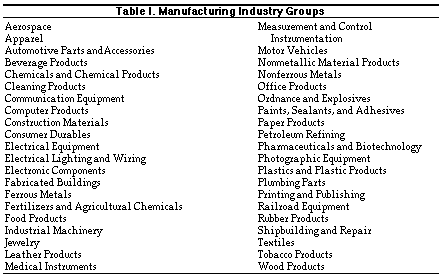
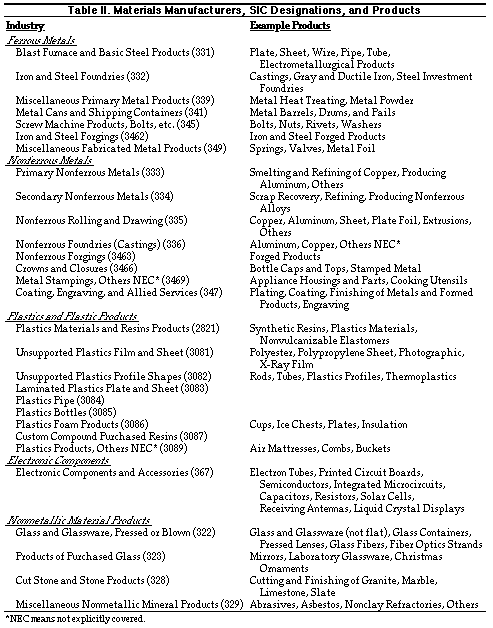
A comparison of the industry groups and products listed in Table II with the
industry groups in Table I suggests that many manufactured products using
advanced materials are excluded from Table II. Aircraft engines, automobile
engines, ball bearings, space vehicle airframes, and prosthetic devices are
only a few of the products manufactured in industries not included. The
categorization is further complicated by the fact that an establishment is
classified by the Census Bureau according to its primary product. A motor
vehicle manufacturer is not included in the materials industries, but many of
its second and third tier suppliers may well be included in these industries.
By the same token, some of the products listed in Table II (e.g., cooking
utensils, receiving antennas, and Christmas tree ornaments) seem out of place
in a materials industry group. However, the existing product-based,
establishment-level classification is convenient in that it carries a rich
data compilation that can be used to examine historical trends. Thus, for this
article, materials industries are considered to be those listed in Table
II.
The Longitudinal Research Database (LRD), maintained by the Census Bureau's
Center for Economic Studies, provided the means to access and organize
exhaustive data files from the Census of Manufacturers, a comprehensive
census of manufacturing establishments conducted every five years in the United
States.3 Supplementing this information was
import and export information from the International Trade Administration's
Industrial Outlook 1989 and Industrial Outlook 1994, covering
the 1985 through 1992 period. From these sources, we compiled 25 year
historical data on the value of shipments, employment, establishment count,
wages, benefits, investment, capital stock, labor productivity, value of
imports, and value of exports.
Information was evaluated for all
manufacturing industries and all five materials manufacturing industries as a
whole, individual industries, and regional levels. Nine distinct geographic
regions covering all 50 states plus the District of Columbia were examined;
three size classifications were defined. The findings for the five materials
industries were compared to results for all manufacturing industries.
The value of shipments from 1967 to 1992 for the materials industries is
shown in Figure 1, which gives the total value of shipments based on 1992 dollar
values. Also shown (as a dashed line) is the ratio of the total value of these
shipments to the total shipments for the 41 industry groups. Figure 2 shows the
value added, defined as the total value of shipments minus inputs (e.g., the
cost of materials, supplies, fuel, electricity, contract labor, etc.). The data
in these two figures indicate that the materials industries represent roughly
15% of all industry shipments. In addition, shipments for the plastics and
electronic components industries have shown strongest growth, the ferrous
metals industry has recovered from a steep downward trend in the 1960s and
1970s, and, since 1982, shipments in the five materials industries have
demonstrated a growth rate exceeding the growth rate of manufacturing in
general.
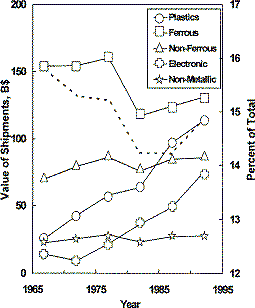 Figure 1. The value of shipments for establishments in the five materials
industries and the ratio of the summed total for the five materials industries
to that for all manufacturing industries (dashed line).
Figure 1. The value of shipments for establishments in the five materials
industries and the ratio of the summed total for the five materials industries
to that for all manufacturing industries (dashed line).
Clicking on the figure will load a larger, clearer GIF file (approximately 28k).
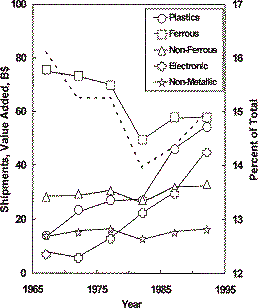 Figure 2. The value added of shipments for establishments in the five
materials industries and the ratio of the summed total for the five materials for
all
manufacturing industries (dashed line).
Figure 2. The value added of shipments for establishments in the five
materials industries and the ratio of the summed total for the five materials for
all
manufacturing industries (dashed line).
Clicking on the figure will load a larger, clearer GIF file (approximately 28k).
The gradual decline in employment in the manufacturing sector has provided
the fuel for much debate. Figure 3 shows 25 year employment figures for the
five materials industries; the decline within the ferrous metals industry group
is
pronounced, although there is some indication that this leveled out at roughly
800,000 workers in 1992. Employment in the nonferrous metals and the
nonmetallic materials groups also demonstrates a gradual decline. These
declines are offset by strong increases in the plastics and electronic
components groups.
Total employment in the materials industries has fluctuated widely, but is on
a decreasing trend. Employment within manufacturing as a whole is decreasing
more rapidly than that within the selected materials industries; thus, the
relative number of workers within the materials industries is increasing.
Dividing the value added of shipments by the number of employees yields a
measure of labor productivity. The data in Figures 2 and 3 indicate that the
value added has been increasing recently while employment has been decreasing,
suggesting a strongly increasing labor productivity. As shown in Figure 4,
however, this has not always been the case. The curves show a clear 15 year
period of steady, even declining, productivity followed by a steady increase
for the past decade. The recent rising productivity has coincided with the
resurgence of global competitiveness of many U.S. manufacturing industries.
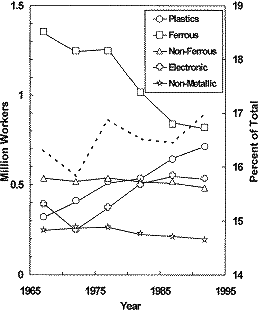 Figure 3. Employment for establishments in the five materials industries and
the ratio of the summed total for the five materials industries to that for all
manufacturing industries (dashed line.)
Figure 3. Employment for establishments in the five materials industries and
the ratio of the summed total for the five materials industries to that for all
manufacturing industries (dashed line.)
Clicking on the figure will load a larger, clearer GIF file (approximately 28k).
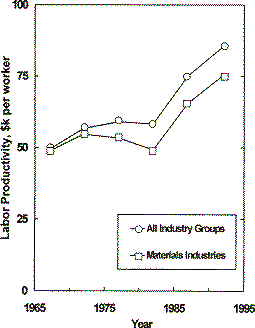 Figure 4. Labor productivity, determined by dividing value added of
shipments by employment, for the materials industries and all manufacturing
industries.
Figure 4. Labor productivity, determined by dividing value added of
shipments by employment, for the materials industries and all manufacturing
industries.
Clicking on the figure will load a larger, clearer GIF file (approximately 28k).
The number of establishments catalogued as materials industries has increased
steadily since 1967. Figure 5 shows the 25 year history of the establishment
count for the five materials industry groups. Both the ferrous and nonferrous
metals industry groups showed a slight decrease in establishment count from
1987 to 1992.
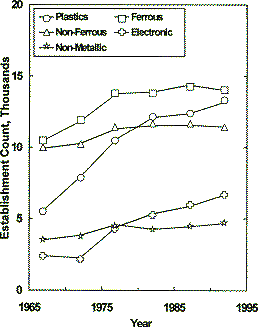 Figure 5. The establishment count for establishments in the five materials
industries.
Figure 5. The establishment count for establishments in the five materials
industries.
Clicking on the figure will load a larger, clearer GIF file (approximately 28k).
The size (employment) of the average manufacturing establishment has been on
the decrease. Dividing total employment by total establishment count yields a
count of 46.4 employees per establishment in 1992, decreasing from 60.9 in
1967. This figure has now dipped below the level often used to distinguish a
small enterprise. The average materials establishment in 1992 was slightly
larger than this at 54.9 (Figure 6).
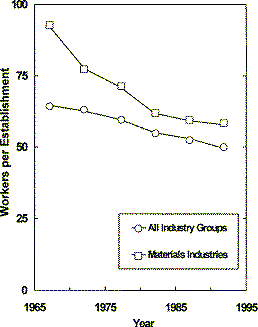 Figure 6. Establishment size, determined as the number of workers per
establishment, illustrating the gradually decreasing average size of
establishments.
Figure 6. Establishment size, determined as the number of workers per
establishment, illustrating the gradually decreasing average size of
establishments.
Clicking on the figure will load a larger, clearer GIF file (approximately 28k).
The distribution of employment as a function of establishment size for the
five materials industry groups in 1992 is shown in Figure 7, which illustrates
that the largest variation among the industry groups is in the more than 1,000
employees size classification. Only 4.1% of employment in the plastics industry
is in establishments with more than 1,000 employees, whereas 29.8% of
employment in the electronic components industry is in establishments of this
size.
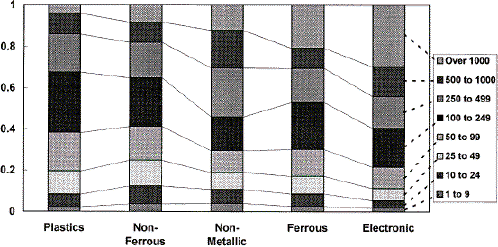 Figure 7. Establishment size distribution in 1992 for the five materials
industry groups.
Figure 7. Establishment size distribution in 1992 for the five materials
industry groups.
Clicking on the figure will load a larger, clearer GIF file (approximately 80k).
Compensation is defined as the sum of salary (or wages) plus benefits. The
history of compensation (deflated to 1992 dollars) over the past 25 years for
each of the materials industry groups is shown in Figure 8a with the average
for all industry groups. Total compensation for the materials groups follows
that for all of manufacturing. Compensation for workers in the ferrous metals
industry group is above that for workers in the other materials industry
groups, although the compensation figures appear to be converging.
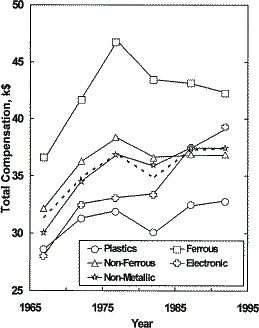 Figure 8a. Total compensation, calculated as the sum of salary (or wages)
plus benefits, for workers in the five materials industries and the ratio of
the average total compensation for workers in the materials industries to that
for all of manufacturing (dashed line).
Figure 8a. Total compensation, calculated as the sum of salary (or wages)
plus benefits, for workers in the five materials industries and the ratio of
the average total compensation for workers in the materials industries to that
for all of manufacturing (dashed line).
Clicking on the figure will load a larger, clearer GIF file (approximately 28k).
Figure 8b shows the variation of wages and salaries for production and
nonproduction workers averaged over all of the materials industry groups. Wages
for materials production workers in 1992 averaged 8.1% above those for
manufacturing as a whole; for nonproduction workers, this differential was only
3.6%. Included in Figure 8b is the dollar value of benefits averaged over all
workers in the materials industry groups. It is apparent that when accounting
for the effects of inflation, salary and wages are at lower levels than
recorded in 1977, and that the noted increase in total compensation noted in
Figure 8a arises from the increasing value of benefits.
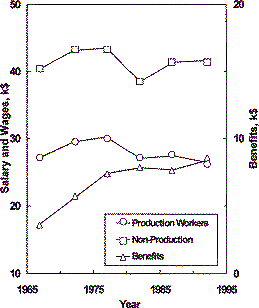 Figure 8b. The average salary and wages for production workers and
nonproduction workers and benefits for all workers within the five materials
industries.
Figure 8b. The average salary and wages for production workers and
nonproduction workers and benefits for all workers within the five materials
industries.
Clicking on the figure will load a larger, clearer GIF file (approximately 28k).
Information is available on both investment for each census year and the
value
of accumulated capital stock for the entire five-year period between census
reports. The former suffers from scatter and a lack of detailed information on
investment over the full five-year time period, whereas the latter suffers from
the fact that it combines investment with depreciation. Figure 9 gives the
value of accumulated capital stock for the five materials industries. Note that
the ferrous metals industry group demonstrates a steadily decreasing value of
capital stock over the entire 25 year period shown. This is likely to be the
result of a transition from large, capital-intensive steel foundries to
smaller, but more versatile, mini-mills. Only capital stocks for the electronic
components and plastics industries demonstrate strongly increasing values.
Included in Figure 9 is the ratio of the value of accumulated capital stock for
the combined materials industry groups to all of manufacturing. Capital stock
has been increasing in value since 1982 for all of manufacturing, but the
materials industries show almost no growth; thus, the ratio of the latter to
the former is decreasing, but in 1992 was still at the 18.0% level. It is
intriguing that this ratio is still above the corresponding ratios of shipments
(14.9%), value added (15.0%), and employment (17.0%), indicating the
capital-intensive nature of materials industries.
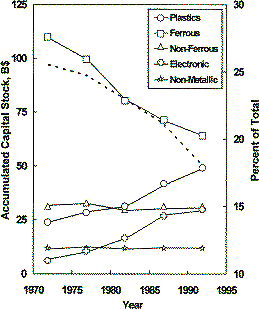 Figure 9. Accumulated capital stock, used as a measure of investment, for
the five materials industries and the ratio of the summed total for the five
materials industries to that for all of manufacturing (dashed line).
Figure 9. Accumulated capital stock, used as a measure of investment, for
the five materials industries and the ratio of the summed total for the five
materials industries to that for all of manufacturing (dashed line).
Clicking on the figure will load a larger, clearer GIF file (approximately 28k).
In general, the data suggest a mixture of encouraging and troublesome trends.
On the healthy side, shipments in these materials industries have been
increasing. In fact, they have been increasing at a rate higher than in
manufacturing as a whole. Although not detailed here, the import and export
data suggest that exports are increasing more rapidly than imports in the
ferrous metals and plastics industry groups (but the inverse is the case in the
electronic components group). Employment has been decreasing, but at a
decreasing rate that has recently been less than that found in manufacturing as
a whole. Labor productivity is increasing strongly. The fact that worker
productivity is increasing without concomitant increases in compensation,
however, is troublesome. Investment—as evidenced by accumulated capital
stock—is increasing more slowly in materials industries than in manufacturing
as a whole.
The trend toward smaller establishments in materials industry groups follows
a general trend within the manufacturing sector. The trend is consistent with
the break-up of large, vertically integrated corporations, the focus on core
competencies within organizations, and the development of stronger supplier
networks and horizontal partnerships. These all represent healthy transitions
in management practices. However, R&D continues to reside primarily in
large establishments; more than one-half of the total industrial R&D
investment (75 percent of which resides in manufacturing industries) and 45
percent of the total company-funded investment are concentrated in companies
with more than 25,000 employees.1 This
dichotomy leads to the prediction that the future competitiveness of
manufacturing industries and the subset of materials industries will require
new mechanisms of innovation and technology development and diffusion. One
response to this developing need has been the emergence of new partnerships
between industry, university, and government laboratory scientists and
engineers.
It must be emphasized that the methodology applied here to address trends
within materials manufacturing industries hides the rich dynamism that exists
at the establishment level.4 For example, total
employment in manufacturing industries is slowly decreasing, but this is the
sum of significant annual job creation and destruction that is not captured by
the integrated figures.5 Although trends and
average behavior within the context of the groupings have been identified and
shed a new light on the state of manufacturing industries, one must use
caution in their interpretation; it is not easy to capture the dynamics and
interactions between 50,000 materials manufacturing establishments employing
2.74 million workers with 1992 shipments totaling more than $430 billion. New
economic analyses that concentrate on the establishment level and show, for
example, the connection between economic growth and technology
utilization,6 are paving the way for a deeper
understanding of the health—and the factors influencing the health—of
manufacturing industries.
This work was performed while I was assigned to the Office of Technology
Policy, Technology Administration, Department of Commerce. The conclusions
contained herein represent mine and not necessarily those of the Department of
Commerce. I am grateful for the contributions of Greg Ehrig and Alex Hou within
the Office of Technology Policy and of Brad Jensen and Bob McGuckin within the
Census Bureau's Center for Economic Studies.
1. Research and Development in Industry: 1992,
Surveys of Science Resources Series, National Science Foundation (1995).
(Information and statistics are preliminary and subject to revision.)
2. Manufacturing in America (tentative title), Office of Technology Policy, Technology Administration, U.S. Department of
Commerce (1996) (forthcoming).
3. The latest full Census of Manufacturers was performed in 1993 and represents the status of manufacturing in 1992.
4. Robert H. McGuckin, "Establishment Microdata for Economic Research and Policy Analysis: Looking Beyond the Aggregates," Journal of Business & Economic Statistics, 13 (1) (1995), pp. 121-126.
5. Steven J. Davis, John C. Haltiwanger, and Scott Schul, Gross Job Flows in U.S. Manufacturing, U.S. Department of Commerce, Bureau of the Census, Center for Economic Studies (1994).
6. Lewis Alexander, Technology, Economic Growth and Employment: New Research from the Department of Commerce, Office of the Chief Economist, U.S. Department of Commerce (December 1994).
Paul S. Follansbee is currently a staff member for the Los Alamos National
Laboratory on assignment with the Office of Economic Competitiveness at the
U.S. Department of Energy.
For more information, contact P. Follansbee, Office of Economic Competitiveness, U.S. Department of Energy, DP-14, FORS, GP-180, 1000 Independence Avenue, Washington, D.C. 20585; (202) 586-1730; fax (202) 586-1057; e-mail paul.follansbee@dp.doe.gov.
Copyright held by The Minerals, Metals & Materials Society, 1996
Direct questions about this or any other JOM page to jom@tms.org.




 Figure 1. The value of shipments for establishments in the five materials
industries and the ratio of the summed total for the five materials industries
to that for all manufacturing industries (dashed line).
Figure 1. The value of shipments for establishments in the five materials
industries and the ratio of the summed total for the five materials industries
to that for all manufacturing industries (dashed line).
 Figure 2. The value added of shipments for establishments in the five
materials industries and the ratio of the summed total for the five materials for
all
manufacturing industries (dashed line).
Figure 2. The value added of shipments for establishments in the five
materials industries and the ratio of the summed total for the five materials for
all
manufacturing industries (dashed line).
 Figure 3. Employment for establishments in the five materials industries and
the ratio of the summed total for the five materials industries to that for all
manufacturing industries (dashed line.)
Figure 3. Employment for establishments in the five materials industries and
the ratio of the summed total for the five materials industries to that for all
manufacturing industries (dashed line.)
 Figure 4. Labor productivity, determined by dividing value added of
shipments by employment, for the materials industries and all manufacturing
industries.
Figure 4. Labor productivity, determined by dividing value added of
shipments by employment, for the materials industries and all manufacturing
industries.  Figure 5. The establishment count for establishments in the five materials
industries.
Figure 5. The establishment count for establishments in the five materials
industries.  Figure 6. Establishment size, determined as the number of workers per
establishment, illustrating the gradually decreasing average size of
establishments.
Figure 6. Establishment size, determined as the number of workers per
establishment, illustrating the gradually decreasing average size of
establishments.  Figure 7. Establishment size distribution in 1992 for the five materials
industry groups.
Figure 7. Establishment size distribution in 1992 for the five materials
industry groups.  Figure 8a. Total compensation, calculated as the sum of salary (or wages)
plus benefits, for workers in the five materials industries and the ratio of
the average total compensation for workers in the materials industries to that
for all of manufacturing (dashed line).
Figure 8a. Total compensation, calculated as the sum of salary (or wages)
plus benefits, for workers in the five materials industries and the ratio of
the average total compensation for workers in the materials industries to that
for all of manufacturing (dashed line).  Figure 8b. The average salary and wages for production workers and
nonproduction workers and benefits for all workers within the five materials
industries.
Figure 8b. The average salary and wages for production workers and
nonproduction workers and benefits for all workers within the five materials
industries.  Figure 9. Accumulated capital stock, used as a measure of investment, for
the five materials industries and the ratio of the summed total for the five
materials industries to that for all of manufacturing (dashed line).
Figure 9. Accumulated capital stock, used as a measure of investment, for
the five materials industries and the ratio of the summed total for the five
materials industries to that for all of manufacturing (dashed line).